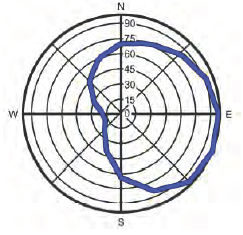Related Resources: calculators
Wind Driven Rain Load Equation and Calculator
Wind Driven Rain Load Review, Equation and Calculator
The load from rain, especially wind-driven rain, is the main reason for moisture-related building failure. Because the requirements of sometimes costly rain-protection measures depend on the local climate, some countries have introduced regional driving rain classifications. Generally, coastal regions and those on the windward side of mountains receive the highest precipitation load. Areas of low rainfall do not have the potential for severe wind driven rain.
Regional precipitation and wind are significant factors in determining local wind-driven rain load, but local exposure conditions are of equal importance. A building in an open field receives a higher load than one sheltered by a forest or other buildings. A quantification of exposure conditions for walls depending on landscape, neighborhood, and building size and geometry can be found in the British Standard BS 8104 and in the European ISO/DIN Standard 15927-3:2006.
The average wind-driven rain load RD in open ground was investigated by Lacy (1965). It is estimated from normal rain RN and the wind velocity component v parallel to the considered orientation:
Rd = f · v · RN
Where:
Rd = wind-driven rain intensity, lb/ft2·h
f = empirical factor = approximately 0.06 s/ft
v = mean wind velocity, ft/s (or mph)
RN = rain intensity on a horizontal surface in open field, lb/ft2·h
Conversion:
1 mph = 1.46667 ft/sec
The image below shows a “rain rose” of results from Equation above plotted in polar coordinates indicating the amount of wind-driven rain in mass per unit area hitting an unobstructed and isolated vertical surface in the open field.

Related:
- Wind Load Support Pole Calculator Spreadsheet
- Wind Loading Analysis Design Wind Load Case 4 from Figure 6-9
- Wind Loading Analysis MWFRS and Components/Cladding
- Wind Loading Analysis For Low Rise Building Excel Spreadsheet Calculator
- Wind Loading Open Structures without Roofs Excel Calculator Spreadsheet
- Wind Loading Analysis Chimneys Stacks, and Vertical Tanks Excel Calculator Spreadsheet
- Wind Loading Analysis For Enclosed or Partially Enclosed Buildings Excel Spreadsheet
Reference:
- ASHRAE Fundamental Handbook, 2019